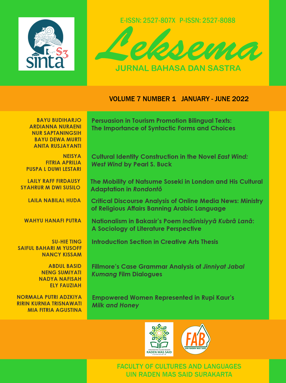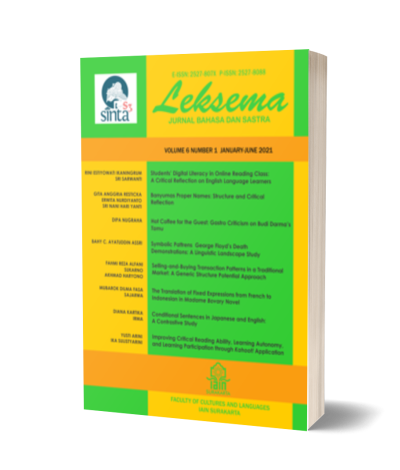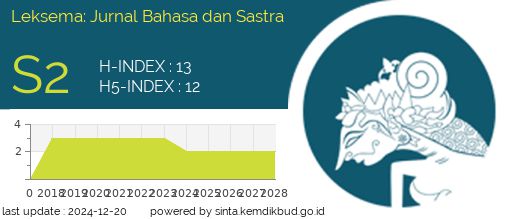PERSUASION IN TOURISM PROMOTION BILINGUAL TEXTS: THE IMPORTANCE OF SYNTACTIC FORMS AND CHOICES
DOI:
https://doi.org/10.22515/ljbs.v7i1.4419Keywords:
syntax, promotion, persuasive force, bilingual textAbstract
This study is aimed at examining the message communicated by verbal material in bahasa Indonesia and English in the Boyolali tourism promotion bilingual booklet. The study employs descriptive qualitative approach and applies qualitative data analysis under the framework of Syntax. The research data take form of sentences in the Boyolali tourism promotion bilingual booklet in bahasa Indonesia and in English. The findings show that Boyolali tourism promotion bilingual booklet carries an inequivalent message in terms of informative content and persuasive force. This research has also proven that syntax is a substantial asset in the formation of promotional messages in the promotion of tourism destinations of Boyolali.
Downloads
References
Arfin, Muhammad, Muhammad Salim, Noor Aireen Ibrahim & Hanita Hassan. 2018. “Authenticating the Tourist Destination on the Official Website of Indonesia: A Multimodal Perspective”. Astra Salvensis-Revista de Istorie Si Cultura 1: 333-343
Atalay, Selin, Siham El Kihal & Florian Ellsaesser. 2020. "The Role of Syntax in Persuasive Marketing Communication: A Natural Language Processing Approach.". https://papers.ssrn.com/sol3/papers.cfm?abstract_id=3410351
Bae, Chul-Hyun. 2008. "Evidence of the Persian Empire’s Multilingualism and Interpretation of DB #70". Proceedings of the SCRIPTA 2008: 135-159
Cahyani, R. Yeni Dewi et al. 2021. "BD-Print: An Android Based for Bilingual Digital Promotion of Integrated Tourism in Garut Selatan". Journal of Physics: Conference Series 1869: 1-6
Valli, Clayton & Ceil Lucas. 2002. Linguistics of American Sign Language: An Introduction. 3rd Edt. Washington: Gallaudet University Press
Fard, Zahra Moeini, Hossein Heidari Tabrizi & Azizeh Chalak. 2014. "Translation Quality Assessment of English Equivalents of Persian Proper Nouns: A Case of Bilingual Tourist Signposts in Isfahan." International Journal of Foreign Language Teaching & Research 2: 24-32
Fasold, Ralph. W., and Jeff Connor-Linton. 2006. An Introduction to Language and Linguistics. Cambridge: Cambridge University Press
Fulginiti, Valentina. 2014. " Il Vocabolario e la Strada." Self-Translation between Standard Italian and Regional Dialects in the Works of Salvatore Di Giacomo, Luigi Capuana, and Luigi Pirandello. Toronto: University of Toronto
Helpiastuti, Selfi. Budi. 2018. “Pengembangan Destinasi Pariwisata Kreatif Melalui Pasar Lumpur (Analisis Wacana Grand Opening Pasar Lumpur Kawasan Wisata Lumpur, Kecamatan Ledokombo, Kabupaten Jember)”. Journal of Tourism and Creativity 2 (1) 13-23
Hilma, Rila. 2011. "Literal Translation Using Google Translate in Translating the Text From French to English in Digital Tourism Brochure Bienvenue a Paris”. Binus Business Review 2 (1): 502-509
Hokenson, Jan Walsh & Marcella Munson. 2007. The Bilingual Text: History and Theory of Literary Self-Translation. Manchester: St Jerome Publishing
Iswari, I Gusti Ayu Shanti. 2015. "The English Postmodified Noun Phrases in Inferno and Their Translation Equivalents in Indonesian with Reference to Neraka”. E-journal Universitas Udayana 1 (2): 1-20
Kuzenko, HM. 2017. "Translation as Cross-cultural Communication." Science and Education a New Dimension. Philology 33 (123): 40-43
Malyuga, Elena N & Barry Tomalin. 2020. "Key Creative Features of Syntactic Design in English-Language Adevrtising Discourse." International Journal of English Linguistics 10 (5): 145-154
Marco Simón, Francisco. 2012. "Power and Evocation of the Exotic. Bilingual Magical Texts in the Latin West." In F. Marco Simón & M. Piranomonte (eds.) Piranomonte: 135-145
Napu, Novianto. 2019. "Tourism Promotional Materials: Translation Problems and Implications on the Text's Effectiveness for Tourism Promotion." 1st International Conference on Education, Social Sciences and Humanities (ICESSHum 2019) Advances in Social Science, Education and Humanities Research: 435-440
Nikolenko, Olga, Olga Zakharchu, Larisa Babakova & Boris Morenko. 2019. "The ‘I’ of the Author and Its Persuasive Function (as Exemplified by the Complex Sentence with Homogeneously Collateral Subclauses)". The International Scientific and Practical Conference: Current Issues of Linguistics and Didactics: The Interdisciplinary Approach in Humanities and Social Sciences (CILDIAH-2019): 1-6
Sianturi, Hertika. 2019. "A Translation Analysis of Tourism Terms from Indonesian into English". Passage 2013 1 (3): 86-93
Sulaiman, Mohamed Zain. 2016. "Pedal to Paradise? The Anglo-Malay Encounter in Tourism Translation". Proceedings of the International Seminar Prasasti III: 29-37
Suryaningtyas, Valentina Widya, Raden Arief Nugroho, Setyo Prasiyanto Cahyono, Mangatur Nababan & Riyadi Santosa. 2019. "Appraisal in Bilingual Tourism Information Media." Asian TEFL 4 (1): 1-12
Topler, Jasna Potočnik. 2018. “Turning Travelogue Readers into Tourists: Representations of Tourism Destinations through Linguistic Features”. Cuadernos de Turismo 42: 447-464
Younesi, Armin, Hossein Navidinia & Amir Raies Ozhan. 2018. "Tourism Discourse Analysis: Comparing the Vocabulary Features Used in the Original and Translation of Iranian Tourism Texts". e-Review of Tourism Research 15: 37-51
Zahiri, Tahereh, Bahador Sadeghi & Ataollah Maleki. 2015. "Strategies and Errors in Translating Tourism Brochures: The Case of EFL Learners". Cumhuriyet Science Journal 36: 2766-2785
Downloads
Published
Issue
Section
License
Copyright (c) 2022 Leksema: Jurnal Bahasa dan Sastra

This work is licensed under a Creative Commons Attribution-NonCommercial-ShareAlike 4.0 International License.
The copyright of the received article shall be assigned to the publisher of the journal. The intended copyright includes the right to publish the article in various forms (including reprints). The journal maintains the publishing rights to published articles.
In line with the license, the authors and users (readers or other researchers) are allowed to share and adapt the material only for non-commercial purposes. In addition, the material must be given appropriate credit, provided with a link to the license, and indicated if changes were made. If authors remix, transform or build upon the material, authors must distribute their contributions under the same license as the original.







